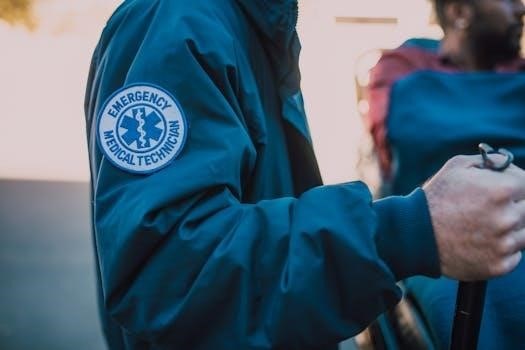
Overview of 2024 First Aid Guidelines
The 2024 guidelines represent a significant update, providing evidence-based practices for first aid responders. These guidelines are co-authored by the American Heart Association and the American Red Cross, covering a wide range of emergencies.
Release and Authorship
The 2024 First Aid Guidelines were officially released on November 14, 2024, marking a crucial update in first aid practices. These guidelines are the result of a collaborative effort between the American Heart Association (AHA) and the American Red Cross (ARC), two leading organizations in emergency care. This partnership has been ongoing since 2005, ensuring a unified and evidence-based approach to first aid. The guidelines reflect the most current research and best practices in the field. The co-authorship highlights a commitment to providing consistent and reliable information to first aid providers, instructors, regulators, and policy makers. This collaboration ensures the guidelines are comprehensive and widely applicable, aiming to improve outcomes in various emergency situations. The release signifies a dedication to equipping responders with the latest knowledge and techniques.

Key Updates in 2024 Guidelines
The 2024 guidelines emphasize evidence-based practices, incorporating new approaches to bleeding control, opioid overdose management, and addressing fainting and tick bites, along with expanded recommendations for emergencies.
Focus on Evidence-Based Practices
The 2024 First Aid Guidelines prioritize evidence-based practices, marking a shift towards methods supported by scientific research and data. This approach ensures that first aid procedures are not only practical but also effective in improving outcomes for individuals experiencing medical emergencies. The guidelines draw from structured reviews conducted by the International Liaison Committee on Resuscitation, which systematically evaluates available research to determine the most appropriate interventions. This focus on evidence means that the recommendations are grounded in the latest scientific findings, enhancing the credibility and efficacy of first aid protocols. By emphasizing evidence-based practices, the 2024 guidelines aim to standardize first aid care, promoting consistent and effective responses to a diverse range of emergency situations, ultimately leading to better patient outcomes and a higher level of safety for all.
Changes in Bleeding Control
The 2024 First Aid Guidelines introduce key changes in bleeding control techniques, emphasizing a more streamlined and effective approach. The primary recommendation for life-threatening bleeding involves the immediate application of direct pressure to the wound; This step is crucial in slowing down blood loss and minimizing the severity of the injury. Following direct pressure, the guidelines suggest the application of a tourniquet when necessary, especially in situations with heavy, uncontrollable bleeding. These changes reflect an effort to simplify the process of bleeding control, ensuring that first aid providers can respond confidently and efficiently in critical situations. The guidelines aim to provide clear, actionable steps that are easy to follow, even under pressure, thus increasing the likelihood of saving lives through prompt and effective bleeding management. The focus is on minimizing the time between injury and intervention.
Opioid Overdose Management
The 2024 guidelines for first aid include updated protocols for managing opioid overdoses, reflecting the increasing need for effective interventions. The guidelines emphasize the importance of recognizing the signs of an opioid overdose, such as slowed or stopped breathing and unresponsiveness. A key update is the recommendation for the administration of naloxone, an opioid antagonist, when available. First aid providers are encouraged to carry and be trained in administering naloxone. The new protocols also stress the importance of continuous monitoring of the person and providing support until advanced medical help arrives. These changes highlight the critical role that first aid responders play in addressing the opioid crisis, equipping them with the necessary tools and knowledge to save lives. The emphasis is on quick action and proper use of naloxone to reverse the effects of an overdose and stabilize the person.
Fainting and Tick Bites
The 2024 first aid guidelines provide specific guidance on managing fainting and tick bites, reflecting the need for clear protocols for these common situations. For fainting, the guidelines emphasize the importance of ensuring the person’s safety by preventing falls and ensuring that they are in a safe position. The guidelines highlight the need to assess the person for any underlying conditions that may have caused the fainting episode. In terms of tick bites, the guidelines provide updated information on the correct removal of ticks and the importance of avoiding squeezing the tick’s body. The new guidelines offer updated advice on observing the bite area for any signs of infection and seeking medical help if needed. These updates provide first aid providers with practical and effective methods for handling these common occurrences, with the aim of preventing further complications or escalation of the situations.
Scope and Applicability
These guidelines are intended for first aid instructors, students, and providers, and cover medical, traumatic, environmental, and toxicological conditions. They are designed for use in various settings and contexts.
Target Audience for the Guidelines
The 2024 First Aid Guidelines are primarily designed for a diverse range of individuals and organizations involved in first aid provision and education. This includes first aid instructors who are responsible for training new first aid providers, ensuring they are equipped with the most current knowledge and techniques. Furthermore, the guidelines are crucial for first aid students, offering them a structured approach to learning and practicing essential life-saving skills. First aid personnel, encompassing individuals who regularly provide first aid in various settings such as workplaces, community events, and recreational activities, will find these guidelines invaluable in their day-to-day practice. Moreover, the guidelines are also aimed at first aid regulators and policy makers, who use them to establish standards and policies for first aid training and practice, ensuring consistency and effectiveness across different regions and organizations. This broad target audience underscores the importance of these guidelines in standardizing first aid practices.
Coverage of Medical Conditions
The 2024 First Aid Guidelines provide comprehensive coverage of a wide array of medical conditions that first aid providers may encounter. These guidelines address both critical and common medical emergencies, ensuring that responders are prepared for diverse scenarios. The scope includes detailed guidance on managing conditions such as heart attacks and strokes, where rapid intervention can significantly impact patient outcomes. The guidelines also cover specific medical situations like fainting, offering updated protocols for assessment and care. Furthermore, they address the management of opioid overdoses, reflecting the current public health concerns and providing specific steps to take in such situations. Additionally, the guidelines detail the treatment of common ailments, emphasizing the importance of early and appropriate care. The extensive coverage ensures that first aid providers are equipped to respond effectively to a broad range of medical incidents, promoting better patient outcomes and overall public safety. This approach is designed to be clear and readily applicable by all first aid providers.
Traumatic, Environmental, and Toxicological First Aid
The 2024 First Aid Guidelines offer significant updates in the management of traumatic, environmental, and toxicological emergencies. For traumatic injuries, the guidelines emphasize the importance of immediate bleeding control, providing detailed steps for applying direct pressure. The document also addresses other common trauma scenarios, such as fractures and dislocations, providing updated protocols for care. In terms of environmental emergencies, the guidelines include specific recommendations for handling conditions like heatstroke and hypothermia, reflecting the growing concern about climate change and its impact on health. Furthermore, the guidelines cover a range of toxicological incidents, addressing different types of poisonings and providing clear protocols for response. They also include new information on managing situations involving bites and stings, including tick bites. The guidelines are designed to ensure first aid providers are equipped to respond effectively to a wide array of non-medical emergencies, ultimately improving patient outcomes in diverse situations.

Implementation and Training
The 2024 guidelines will impact first aid courses, necessitating curriculum updates to reflect the new recommendations. Changes to workplace first aid training are also expected to align with these updated standards.
Impact on First Aid Courses
The release of the 2024 First Aid Guidelines necessitates significant changes in the structure and content of first aid training programs. These updates, stemming from the American Heart Association and the American Red Cross, aim to incorporate the latest evidence-based practices, ensuring that first aid providers are equipped with the most current and effective techniques. Curriculum adjustments will be essential to address new recommendations for managing various medical, traumatic, and environmental emergencies. Educators will need to integrate the expanded guidance on opioid overdoses, fainting, and tick bites into their teaching modules. Furthermore, the emphasis on practical application and skill development will require modifications to training delivery methods. These changes will affect both initial certification and recertification courses, ensuring a consistent level of preparedness across all first aid providers, while maintaining the integrity and effectiveness of training programs. The focus will also shift towards promoting a more proactive and comprehensive approach to first aid.
Workplace First Aid Curriculum Changes
The 2024 First Aid Guidelines will bring substantial changes to workplace first aid curricula, aligning with the latest standards and best practices. These changes, influenced by the American Heart Association and the American Red Cross, emphasize evidence-based approaches to emergency response. Employers must update their training programs to reflect new protocols for bleeding control, opioid overdose management, and addressing fainting and tick bites. The curriculum will need to incorporate detailed guidance on these conditions, ensuring that workplace first responders are equipped to handle these scenarios effectively. Furthermore, the updated guidelines may require adjustments to the types and quantities of first aid supplies kept on site. These modifications aim to enhance the overall safety and preparedness of workplaces by providing employees with the knowledge and skills necessary to respond to a variety of medical emergencies. Integration with Canadian Standards Association (CSA) guidelines will also be a crucial part of these updates.

Canadian Standards Alignment
The 2024 guidelines will be integrated with the Canadian Standards Association (CSA) guidelines, ensuring a high quality and consistent approach to first aid training across Canada, with updated regulations.
Integration with CSA Guidelines
The alignment of the 2024 First Aid Guidelines with the Canadian Standards Association (CSA) standards is a crucial step in ensuring uniformity and quality in first aid practices across Canada. These changes aim to synchronize the latest evidence-based approaches with the established Canadian framework. This integration impacts workplace first aid requirements, necessitating updates to training programs and protocols. Employers and first aid providers must become familiar with these integrated guidelines to ensure they are meeting the current standards. The move towards this harmonization also aims to streamline first aid training, making it more consistent for individuals who receive first aid certification and those who may need to apply it. It is also crucial for workplaces to update their approach to integrate both physical and mental health first aid, as experts suggest. This alignment also enhances the credibility of first aid certifications, as they now represent a national consensus on best practices.

Additional Resources
The complete 2024 First Aid Guidelines are available on the official websites of the American Heart Association and the American Red Cross. These resources provide detailed information for first aid providers and instructors.
Where to Find the Full Guidelines
The complete and comprehensive 2024 First Aid Guidelines, co-authored by the American Heart Association (AHA) and the American Red Cross (ARC), are accessible through their official websites. These guidelines are crucial for first aid instructors, students, and all personnel involved in providing first aid. The documents delve into the science and rationale behind the updated recommendations, which are designed to enhance first aid training and practice. You can find the full guidelines on their respective websites, often within the ‘First Aid’ or ‘Guidelines’ sections. These resources offer the detailed updates and changes, which are essential to understand the new approaches to first aid. Also, these organizations provide access to related materials and support for understanding and applying the new standards. These materials will assist in the implementation of these important changes for all stakeholders. It is important to note, that at this time, no changes to Heartsaver courses or training are available. Stay up to date!